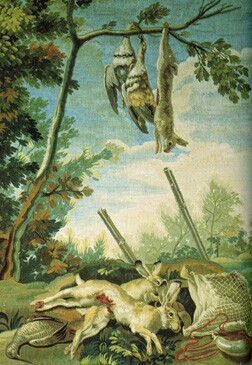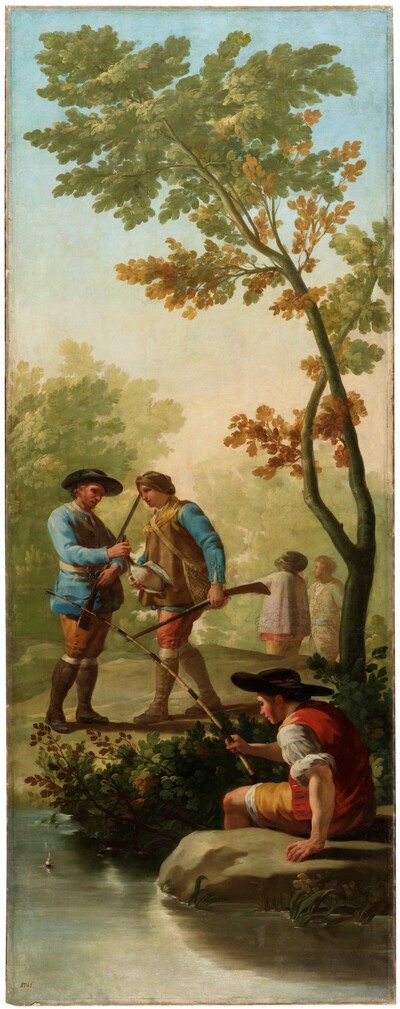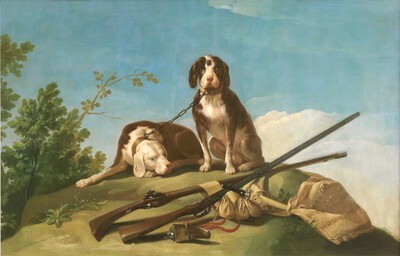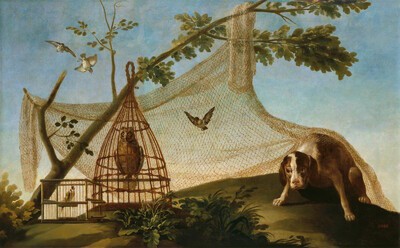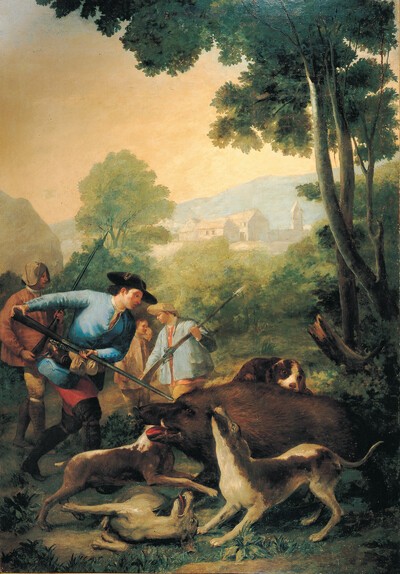- Cronología
- 1775
- Dimensiones
- 171 x 51 cm
- Técnica y soporte
- Oil on canvas
- Reconocimiento de la autoría de Goya
- Documented work
- Titular
- Private collection
- Ficha: realización/revisión
- 05 Nov 2009 / 14 Jun 2023
For the history of the whole series, see Wild Boar Hunt.
In addition to the different attributions made in relation to this series of cartoons and the documentation of Goya's authorship made by Sambricio, the work before us was again attributed to Ramón Bayeu by Vicente López in the inventory that he carried out in 1834 for Ferdinand VII's will.
In 1870, several tapestry cartoons were moved from the Royal Palace in Madrid to the Prado Museum. It was then that the disappearance of six works by Goya was noticed (see Children with a Cart). Boys Hunting with Owl also went missing but, due to the fact that at that time it was attributed to Ramón Bayeu, its disappearance was not noted. It was not until 1873, after the resignation of Antonio Gisbert as director of the Prado Museum, that its absence was noticed. Sambricio was of the opinion that it did not disappear from the museum, despite appearing on the list of works sent in 1870, but rather that it never reached there in the first place and that it was probably taken from the Palacio de Oriente, together with the other paintings by Goya mentioned above.
We do not know what happened to the work until it came to form part of the Apolinar Sánchez Collection, arriving from the collection of the Marquises of Valverde. Later it was in the collection of Abelardo Linares de Madrid, and finally entered the Viñas Collection in Barcelona.
The scene depicts three boys, and an owl on top of a crutch.
Thanks to previous documents which record the painting as having a different height, and to the tapestry (Madrid, Spanish National Heritage Board), we know that the top part of the cartoon, which featured a bird in flight and the extension of the main tree, has been cut off. The motivation behind this action was almost certainly a commercial one, in order to give this work, which was originally conceived for a very tall and narrow corner, more harmonic proportions. Sambricio believed that the work was still whole when it belonged to the Abelardo Linares Collection.
-
cat. 2
-
Tapices de GoyaMadridPatrimonio Nacional1946pp. 50, 55, 67, 151, 197, cat. 8 y láms.
-
Vie et ouvre de Francisco de GoyaParísOffice du livre1970pp. 74-75, 85, cat. 68
-
BarcelonaPolígrafa1970vol. I, p. 244, cat. 57
-
L’opera pittorica completa di GoyaMilanRizzoli1974p. 92, cat. 54
-
Francisco de Goya, 4 vols.ZaragozaCaja de Ahorros de Zaragoza, Aragón y Rioja1980-1982vol. I, pp. 77-78
-
Francisco de Goya, cartones y tapicescol. col. "Espasa Arte"Espasa Calpe1987pp. 46, 58, 60, 64, 242, cat. 8C y p. 59
-
Francisco de Goya. Los cartones para tapices y los comienzos de su carrera en la corte de Madridcol. col. "Ensayos de Arte Cátedra"MadridCátedra1987p. 43
-
Goya. Catálogo de la pinturaZaragozaReal Academia de Nobles y Bellas Artes de San Luis1994p. 138, cat. 49

